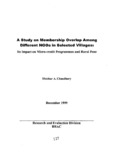| dc.description.abstract | For several decades BRAC and many other NGOs have been working with micro credit for
alleviating rural poverty. The growth of micro credit has therefore been phenomenal, and so
has the number of smaller NGOs working along this line. According to one estimate,
Grameen Bank together with other NGOs account for 65 percent of total rural credit
disbursement annually, a figure surpassing the combined total of GOs and Banks.
The present study looked into the phenomenon of membership overlapping in some villages
of Tangail. The study was exploratory in nature and the findings suggest that a majority of
the sample borrowers have benefited from multiple borrowings, while others have not been
so successful and some even ended up as paupers. Incidence of membership overlapping is
high and its prevalence is likely to be found in other parts of the country as well. These have
wide ranging implications for the provider of funds.
The objective of the study has been to identify the nature and causes of the incidence of
membership overlap between different NGOs in selected villages and evaluate its impact on
micro-credit programmes and rural poor.
The database for the present study came from field level investigations which were
conducted in 10 BRAC village organizations (VOs) under three thanas of Tangail. Out of a
total of 326 members in the 10 VOs, Focus Group Discussions were held with 115 members.
In-depth interviews of 39 multiple members along with nine case studies were taken from
this sample. Besides BRAC, these borrowers also have membership in several other NGOs
such as Grameen Bank, Proshika, ASA, Society for Social Services (SSS), Social
Development Sangshad (SDS), Swanirvar Bangladesh and BURO Tangail.
The major findings of the study indicate that:
There is a high incidence of membership overlap. Its prevalence has been found to be
very widespread in the study area.
A majority of the multiple borrowers are landless, illiterate and enjoy relatively good
networking privileges.
The motivating factor, behind membership overlapping, revolves around the inadequacy
of loans obtained from their parent organization to meet one or any combination of the
following categories of loans: (i) credit required to carry on and expand agriculture,
cottage industry and business (ii) credit needed to meet long standing problems such as
house construction or repair or meet social obligations such as marriage, etc. (iii) credit
needed to cope crisis such as unemployment, accident, etc.
Data show that 69.73 percent of the loan has been utilized by the multiple borrowers for
productive uses and 30.27 percent for unproductive uses. The end use of the loan have
been traced to housing (5.40 percent), purchase of cow (6.30 percent), marriage (5.19
percent), medical treatment due to sickness/accident (3.20 percent) and paying loan
installment of another NGO ( 4.04 percent). Two percent of the loan has been used for relending
at an exorbitant rate of interest.
The study found repayment performance of the major multiple borrowers to be regular.
Out of a total of 326 borrowers, 210 (64.42 percent) have been regular in repaying loan
installments, 63 ( 19.33 percent) have been irregular and 53 ( 16.26 percent) defaulted.
CJ The study found that most of the multiple borrowers do not approve of overlapping.
According to them, there should be no more than one NGO in a village. Borrowers
pointed out that NGOs are charging high interest rates that should be lowered. They are
also unhappy with BRAC and Grameen Bank, who do not allow members to withdraw
savings any time.
CJ Out of the total borrowers, 117 (35 .89 percent) thought that they were better-off, 125
(38.34 percent) said their improvements have been moderate and 84 (25.77 percent)
suggested that no improvement has occurred in their lives.
CJ Multiple borrowers have invested 21.89 percent of the total cumulative loan in building
up productive assets and 8.35 percent in unproductive assets.
CJ Access to health-care facilities, safe drinking water and sanitation has showed marked
improvement.
The force of competition has also resulted in bigger NGOs offering attractive and
innovative credit and savings schemes. On the other hand, the smaller NGOs are mostly
disadvantaged and borrowers have little reliance on them particularly regarding their
sustainability.
Records of fraudulent practices of several NGOs have also been documented. Though
these NGOs did not last for long, it has greatly tarnished the image of the NGOs in the
localilty.
Multiple loans have rejuvenated, to some extent, trading and marketing activity in the
local economy. In some areas they have invigorated certain sectors of the local economy
(paddy and rice-making business, mustard oil production and distribution, puffed rice
business, manufacture of earthen-pot for curd, among others).
With a view to reducing membership overlap, the study recommends the following :
• initiating steps to streamline the differences among NGOs regarding loan ceiling,
interest rate, borrowers' access to their savings, provisions for contingency loans,
allowance for supplementary loans and refinancing options, and initiating
discussion meeting among the NGOs to avoid overlapping and to allocate areas
of operation
• devising and developing an effective mechanism for supervision and monitoring
ofborrowers' credit use activities
• · proposing to the government to issue registration of new NGOs with proper care
so that spurious NGOs do not crop up.
A host of interesting issues and concerns have been raised by the study. They mainly
relate to the success and sustainability of the lending programmes, the dynamics of
default and their overall impact on poverty situation. Time and resource constraints have,
however, forced the present study to narrow down many areas of interest related to the
inquiry. Future researchers could dig deeper into these areas through follow-up and indepth
studies. | en_US |

